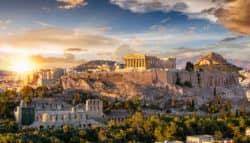A trip to Athens isn’t complete without a visit to The Acropolis, which is visible from almost everywhere in the city. It is  considered by some to be the most important site in the Western World.
considered by some to be the most important site in the Western World.
The Acropolis was first inhabited in Neolithic times (4000-3000 BC) and the first temples were built during the Mycenaean era in homage to the goddess Athena. After the Battle of Salamis (400 BC), the Persians reduced all of the buildings on the Acropolis to ashes and Pericles set about an ambitious rebuilding program by transforming the Acropolis into a city of temples.
Major restorations continue at the Acropolis and many original sculptures have been moved to the Acropolis Museum and replaced with casts. When planning a trip to the Acropolis, arrive early or go late, as it gets very crowded during the day.
Primary Sites of the Acropolis:
Beule Gate & Monument of Agrippa
The Beule Gate & Monument of Agrippa were named after the French archaeologist Ernest Beule who uncovered it in 1852. It is located halfway up the zig-zagging ramp leading to the Propylaia. It was once topped by the Monument of Agrippa, a bronze statue of the Roman general riding a chariot that was erected in 27 BC to commemorate victory in the Panathenaic Games.
Propylaia
The Propylaia is the monumental entrance to the Acropolis. Mnesicles built it between 437 BC and 432 BC. Its architectural brilliance matches that of the Parthenon, which it is aligned with. It is the earliest example of a building designed in relation to another.
Temple of Athena Nike
The Temple of Athena Nike stands on a platform perched atop the steep southwest edge of the Acropolis, to the right of the Proplylaia. The tiny Pentelic marble temple was designed by Kallicrates and built around 425 BC and has recently been restored. It housed a wooden statue of Athena as Victory (Nike) and the exterior friezes illustrated Athenian battle triumphs.
Statue of Thena Promachos
The Statue of Thena Promachos symbolizes Athenian invincibility against the Persians. The helmeted goddess held a shield her left hand and a spear in her right.
The Parthenon epitomizes the glory of Ancient Greece. Parthenon means “virgin’s apartment” and is dedicated to Athena Parthenos, the goddess embodying the power and prestige of the city. It is the largest Doric temple every completed in Greece and the only one build completely of Pentelic marble. It took 15 years to complete.
The Erechtheion is a sanctuary built on the part of the Acropolis that is held most sacred. It is named after Erechtheus, a mythical king of Athens. It housed the cults of Athena, Poseidon, and Erechtheus. The Erechtheion is immediately recognizable by the six larger than life maiden columns that support its southern portico, called the Caryatids. The Caryatids were modeled on women from Karyai. Currently, the Caryatids seen are plaster casts. The originals are in the Acropolis Museum.

